2015 NISSAN FRONTIER lock
[x] Cancel search: lockPage 446 of 466
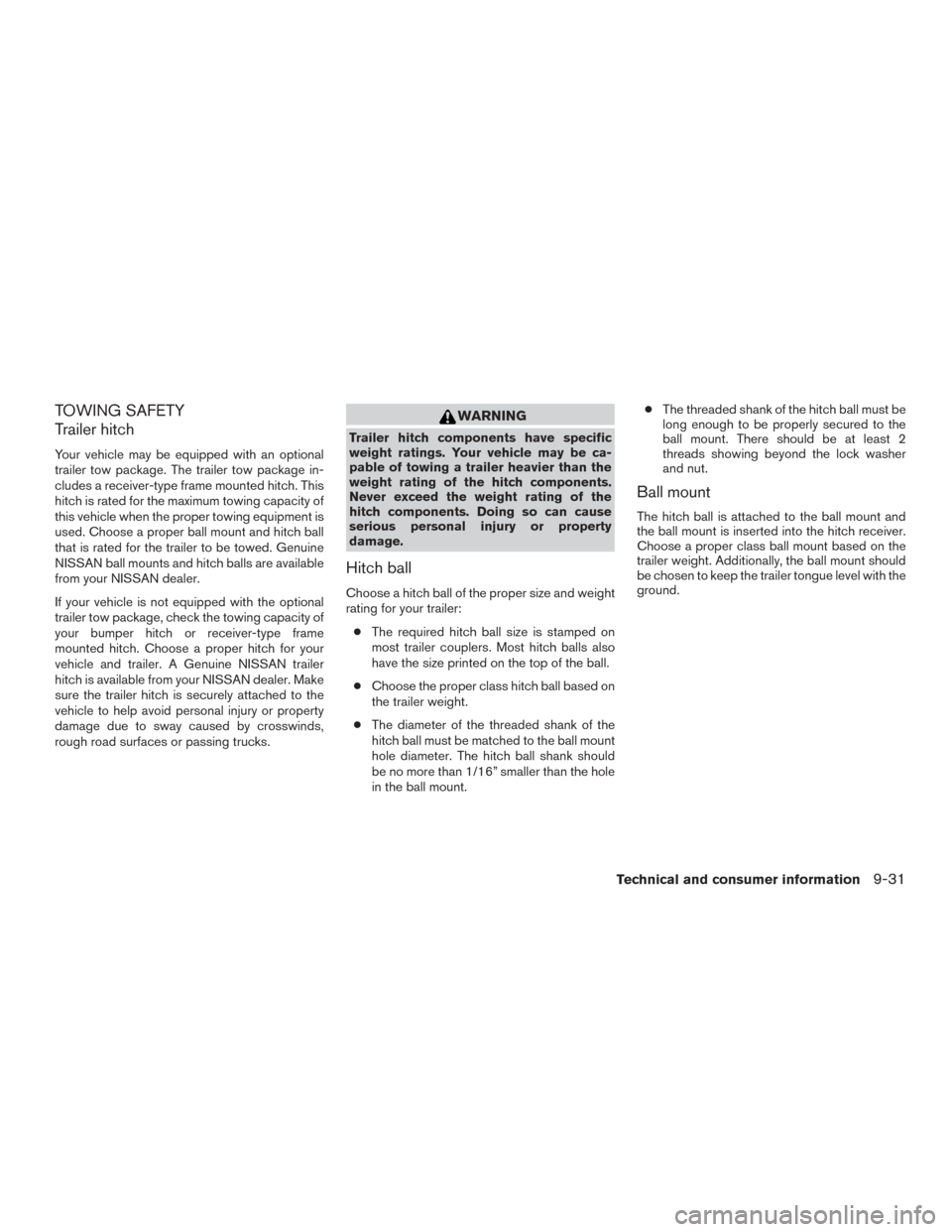
TOWING SAFETY
Trailer hitch
Your vehicle may be equipped with an optional
trailer tow package. The trailer tow package in-
cludes a receiver-type frame mounted hitch. This
hitch is rated for the maximum towing capacity of
this vehicle when the proper towing equipment is
used. Choose a proper ball mount and hitch ball
that is rated for the trailer to be towed. Genuine
NISSAN ball mounts and hitch balls are available
from your NISSAN dealer.
If your vehicle is not equipped with the optional
trailer tow package, check the towing capacity of
your bumper hitch or receiver-type frame
mounted hitch. Choose a proper hitch for your
vehicle and trailer. A Genuine NISSAN trailer
hitch is available from your NISSAN dealer. Make
sure the trailer hitch is securely attached to the
vehicle to help avoid personal injury or property
damage due to sway caused by crosswinds,
rough road surfaces or passing trucks.
WARNING
Trailer hitch components have specific
weight ratings. Your vehicle may be ca-
pable of towing a trailer heavier than the
weight rating of the hitch components.
Never exceed the weight rating of the
hitch components. Doing so can cause
serious personal injury or property
damage.
Hitch ball
Choose a hitch ball of the proper size and weight
rating for your trailer:● The required hitch ball size is stamped on
most trailer couplers. Most hitch balls also
have the size printed on the top of the ball.
● Choose the proper class hitch ball based on
the trailer weight.
● The diameter of the threaded shank of the
hitch ball must be matched to the ball mount
hole diameter. The hitch ball shank should
be no more than 1/16” smaller than the hole
in the ball mount. ●
The threaded shank of the hitch ball must be
long enough to be properly secured to the
ball mount. There should be at least 2
threads showing beyond the lock washer
and nut.
Ball mount
The hitch ball is attached to the ball mount and
the ball mount is inserted into the hitch receiver.
Choose a proper class ball mount based on the
trailer weight. Additionally, the ball mount should
be chosen to keep the trailer tongue level with the
ground.
Technical and consumer information9-31
Page 450 of 466
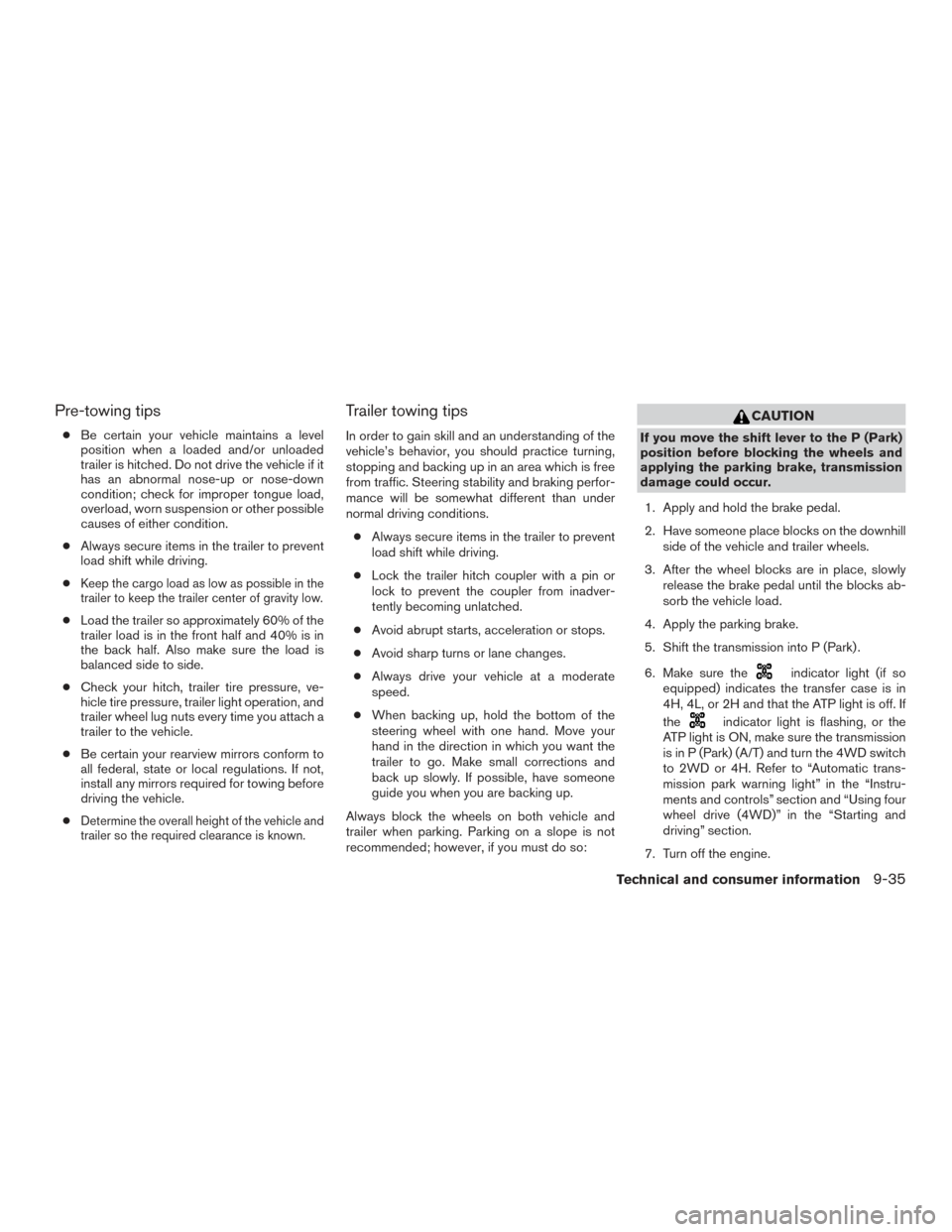
Pre-towing tips
●Be certain your vehicle maintains a level
position when a loaded and/or unloaded
trailer is hitched. Do not drive the vehicle if it
has an abnormal nose-up or nose-down
condition; check for improper tongue load,
overload, worn suspension or other possible
causes of either condition.
● Always secure items in the trailer to prevent
load shift while driving.
●
Keep the cargo load as low as possible in the
trailer to keep the trailer center of gravity low.
● Load the trailer so approximately 60% of the
trailer load is in the front half and 40% is in
the back half. Also make sure the load is
balanced side to side.
● Check your hitch, trailer tire pressure, ve-
hicle tire pressure, trailer light operation, and
trailer wheel lug nuts every time you attach a
trailer to the vehicle.
● Be certain your rearview mirrors conform to
all federal, state or local regulations. If not,
install any mirrors required for towing before
driving the vehicle.
●
Determine the overall height of the vehicle and
trailer so the required clearance is known.
Trailer towing tips
In order to gain skill and an understanding of the
vehicle’s behavior, you should practice turning,
stopping and backing up in an area which is free
from traffic. Steering stability and braking perfor-
mance will be somewhat different than under
normal driving conditions.
● Always secure items in the trailer to prevent
load shift while driving.
● Lock the trailer hitch coupler with a pin or
lock to prevent the coupler from inadver-
tently becoming unlatched.
● Avoid abrupt starts, acceleration or stops.
● Avoid sharp turns or lane changes.
● Always drive your vehicle at a moderate
speed.
● When backing up, hold the bottom of the
steering wheel with one hand. Move your
hand in the direction in which you want the
trailer to go. Make small corrections and
back up slowly. If possible, have someone
guide you when you are backing up.
Always block the wheels on both vehicle and
trailer when parking. Parking on a slope is not
recommended; however, if you must do so:
CAUTION
If you move the shift lever to the P (Park)
position before blocking the wheels and
applying the parking brake, transmission
damage could occur.
1. Apply and hold the brake pedal.
2. Have someone place blocks on the downhill side of the vehicle and trailer wheels.
3. After the wheel blocks are in place, slowly release the brake pedal until the blocks ab-
sorb the vehicle load.
4. Apply the parking brake.
5. Shift the transmission into P (Park) .
6. Make sure the
indicator light (if so
equipped) indicates the transfer case is in
4H, 4L, or 2H and that the ATP light is off. If
the
indicator light is flashing, or the
ATP light is ON, make sure the transmission
is in P (Park) (A/T) and turn the 4WD switch
to 2WD or 4H. Refer to “Automatic trans-
mission park warning light” in the “Instru-
ments and controls” section and “Using four
wheel drive (4WD)” in the “Starting and
driving” section.
7. Turn off the engine.
Technical and consumer information9-35
Page 451 of 466
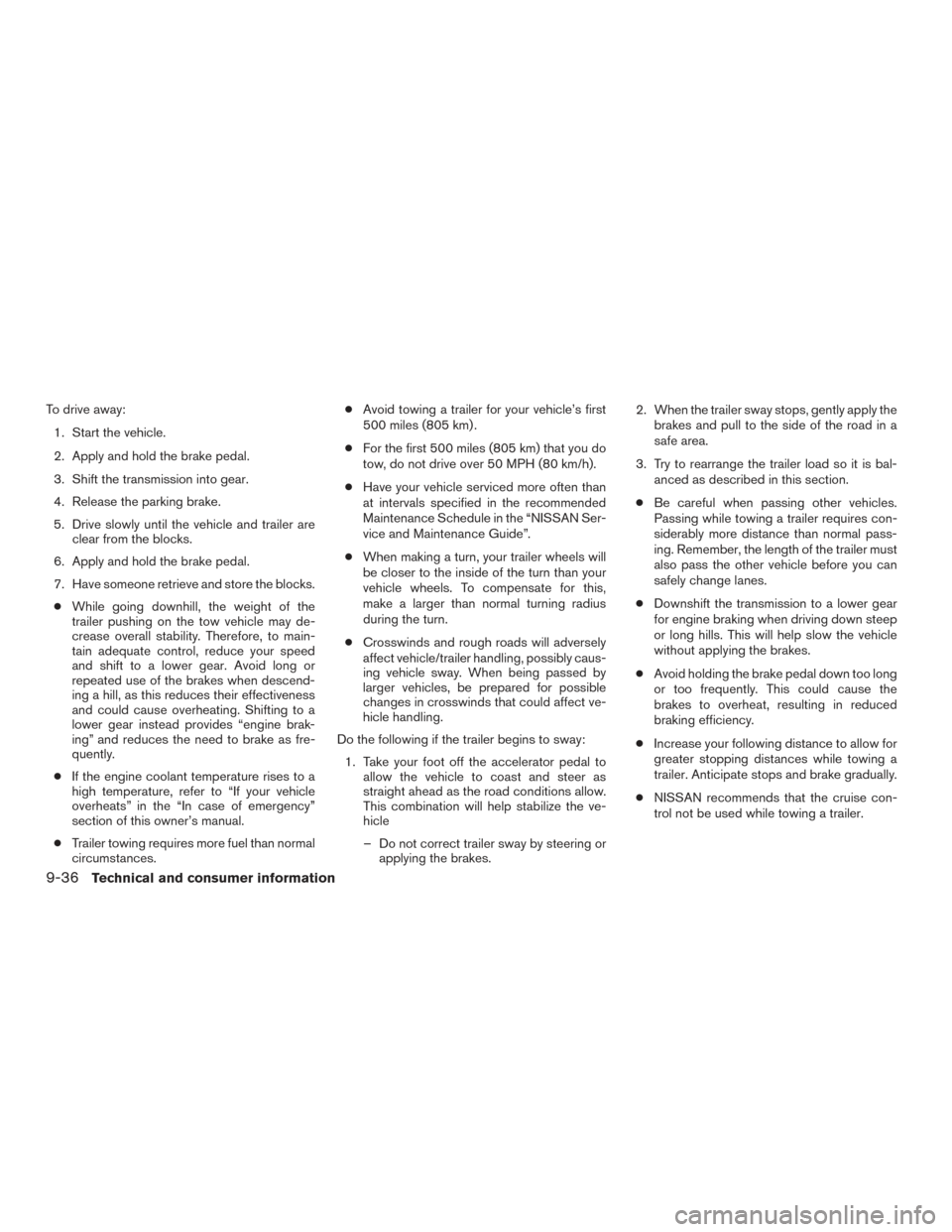
To drive away:1. Start the vehicle.
2. Apply and hold the brake pedal.
3. Shift the transmission into gear.
4. Release the parking brake.
5. Drive slowly until the vehicle and trailer are clear from the blocks.
6. Apply and hold the brake pedal.
7. Have someone retrieve and store the blocks. ● While going downhill, the weight of the
trailer pushing on the tow vehicle may de-
crease overall stability. Therefore, to main-
tain adequate control, reduce your speed
and shift to a lower gear. Avoid long or
repeated use of the brakes when descend-
ing a hill, as this reduces their effectiveness
and could cause overheating. Shifting to a
lower gear instead provides “engine brak-
ing” and reduces the need to brake as fre-
quently.
● If the engine coolant temperature rises to a
high temperature, refer to “If your vehicle
overheats” in the “In case of emergency”
section of this owner’s manual.
● Trailer towing requires more fuel than normal
circumstances. ●
Avoid towing a trailer for your vehicle’s first
500 miles (805 km) .
● For the first 500 miles (805 km) that you do
tow, do not drive over 50 MPH (80 km/h).
● Have your vehicle serviced more often than
at intervals specified in the recommended
Maintenance Schedule in the “NISSAN Ser-
vice and Maintenance Guide”.
● When making a turn, your trailer wheels will
be closer to the inside of the turn than your
vehicle wheels. To compensate for this,
make a larger than normal turning radius
during the turn.
● Crosswinds and rough roads will adversely
affect vehicle/trailer handling, possibly caus-
ing vehicle sway. When being passed by
larger vehicles, be prepared for possible
changes in crosswinds that could affect ve-
hicle handling.
Do the following if the trailer begins to sway: 1. Take your foot off the accelerator pedal to allow the vehicle to coast and steer as
straight ahead as the road conditions allow.
This combination will help stabilize the ve-
hicle
– Do not correct trailer sway by steering or applying the brakes. 2. When the trailer sway stops, gently apply the
brakes and pull to the side of the road in a
safe area.
3. Try to rearrange the trailer load so it is bal- anced as described in this section.
● Be careful when passing other vehicles.
Passing while towing a trailer requires con-
siderably more distance than normal pass-
ing. Remember, the length of the trailer must
also pass the other vehicle before you can
safely change lanes.
● Downshift the transmission to a lower gear
for engine braking when driving down steep
or long hills. This will help slow the vehicle
without applying the brakes.
● Avoid holding the brake pedal down too long
or too frequently. This could cause the
brakes to overheat, resulting in reduced
braking efficiency.
● Increase your following distance to allow for
greater stopping distances while towing a
trailer. Anticipate stops and brake gradually.
● NISSAN recommends that the cruise con-
trol not be used while towing a trailer.
9-36Technical and consumer information
Page 458 of 466

10 Index
4WDwarninglight...............2-17A
Active brake limited slip (ABLS) system . . .5-36
Air bag (See supplemental restraint
system) .....................1-70
Air bag system Front (See supplemental front impact air bag
system) ...................1-77
Airbagwarninglabels.............1-84
Airbagwarninglight...........1-85,2-20
Air bag warning light, supplemental . .1-85, 2-20
Air cleaner housing filter ............8-21
Air conditioner Air conditioner operation ..........4-24
Air conditioner service ...........4-34
Air conditioner specification label .....9-14
Air conditioner system refrigerant and
oil recommendations .............9-8
Heater and air conditioner
controls............4-15,4-21,4-32
Servicing air conditioner ..........4-34
Airflowcharts..............4-18,4-25
Alarm system (See vehicle security system). .2-24
Anchor point locations .............1-31
Antenna .....................4-71
Anti-lock brake warning light ..........2-15
Anti-lock Braking System (ABS) ........5-35
Apps .......................4-71
Audible reminders ...............2-24
Audio system ..................4-34 AMradioreception.............4-35
Bluetooth®audio..............4-67
Compact disc (CD) player . .4-44, 4-49, 4-56
FM-AM radio with compact disc (CD)
player ....................4-42
FM/AM/SAT radio with compact disc (CD)
player.................4-46,4-51
FMradioreception.............4-34
iPod® Player
.............4-61,4-63
iPod® player operation .......4-61,4-63
Radio ....................4-34
Steering wheel audio control switch . . .4-69
USB interface ............4-57,4-59
USB (Universal Serial Bus) Connection
Port..................4-57,4-59
Autolight switch .................2-29
Automatic Automatic power window switch .....2-50
Automatic transmission position indicator
light .....................2-20
Driving with automatic transmission ....5-13
Automatic anti-glare inside mirror .......3-15
Automatic door locks ..............3-5
AUXjack.................4-45,4-57
B
Backbutton....................4-7
Battery ..................5-41,8-17
Chargewarninglight............2-16
Battery replacement Keyfob ...................8-30 Before starting the engine
...........5-12
Belt (See drive belt) ..............8-20
Block heater Engine ....................5-42
Bluetooth® audio ................4-67
Bluetooth® hands-free phone
system...............4-73,4-87,4-97
Boosterseats..................1-65
Brake Anti-lock Braking System (ABS) ......5-35
Brake fluid ..................8-15
Brakelight(Seestoplight).........8-33
Brake system ................5-34
Brakewarninglight.............2-16
Brakewearindicators........2-24,8-25
Parking brake operation ..........5-20
Self-adjusting brakes ............8-25
Brake fluid ....................8-15
Brakes ......................8-25
Brake system ..................5-34
Break-inschedule ...............5-22
Brightness/contrast button ...........4-9
Brightness control Instrument panel ..............2-31
Bulb check/instrument panel ..........2-15
Bulbreplacement................8-33
C
Capacities and recommended fuel/lubricants..9-2
Cargolightswitch ...............2-33
Cargo (See vehicle loading information) . . .9-15
Page 459 of 466
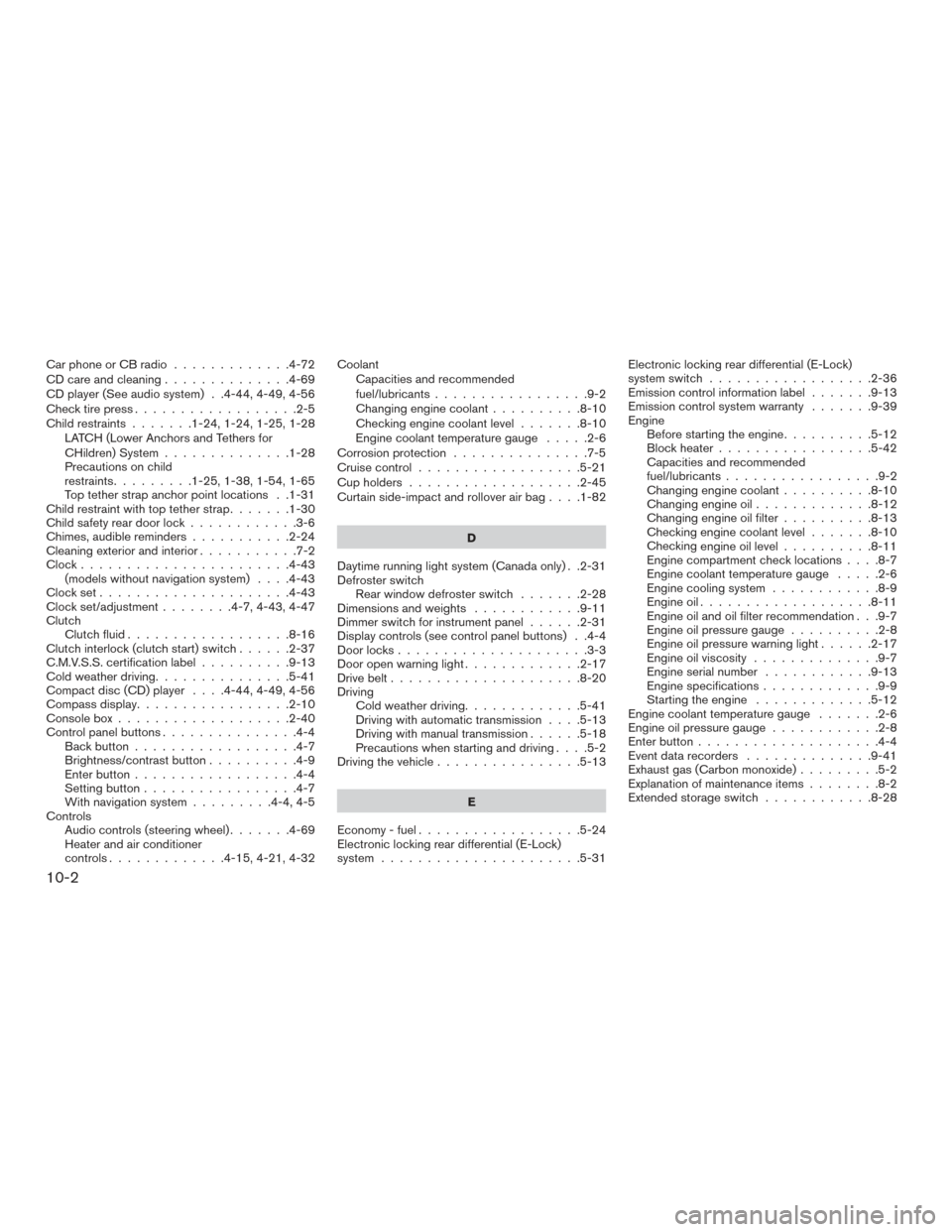
Car phone or CB radio.............4-72
CD care and cleaning ..............4-69
CD player (See audio system) . .4-44, 4-49, 4-56
Check tire press ..................2-5
Child restraints .......1-24,1-24,1-25,1-28
LATCH (Lower Anchors and Tethers for
CHildren) System ..............1-28
Precautions on child
restraints.........1-25,1-38,1-54,1-65
Top tether strap anchor point locations . .1-31
Child restraint with top tether strap .......1-30
Child safety rear door lock ............3-6
Chimes, audible reminders ...........2-24
Cleaningexteriorandinterior...........7-2
Clock.......................4-43 (models without navigation system) ....4-43
Clockset.....................4-43
Clock set/adjustment ........4-7,4-43,4-47
Clutch Clutch fluid ..................8-16
Clutch interlock (clutch start) switch ......2-37
C.M.V.S.S. certification label ..........9-13
Cold weather driving ...............5-41
Compact disc (CD) player ....4-44,4-49,4-56
Compass display .................2-10
Consolebox...................2-40
Control panel buttons ...............4-4
Backbutton..................4-7
Brightness/contrast button ..........4-9
Enterbutton..................4-4
Setting button .................4-7
With navigation system .........4-4,4-5
Controls Audiocontrols(steeringwheel).......4-69
Heater and air conditioner
controls.............4-15,4-21,4-32 Coolant
Capacities and recommended
fuel/lubricants .................9-2
Changingenginecoolant..........8-10
Checking engine coolant level .......8-10
Engine coolant temperature gauge .....2-6
Corrosion protection ...............7-5
Cruisecontrol..................5-21
Cupholders...................2-45
Curtainside-impactandrolloverairbag....1-82
D
Daytime running light system (Canada only) . .2-31
Defroster switch Rear window defroster switch .......2-28
Dimensionsandweights ............9-11
Dimmer switch for instrument panel ......2-31
Display controls (see control panel buttons) . .4-4
Door locks .....................3-3
Door open warning light .............2-17
Drive belt .....................8-20
Driving Cold weather driving .............5-41
Driving with automatic transmission ....5-13
Driving with manual transmission ......5-18
Precautions when starting and driving ....5-2
Driving the vehicle ................5-13
E
Economy - fuel ..................5-24
Electronic locking rear differential (E-Lock)
system ......................5-31 Electronic locking rear differential (E-Lock)
system switch
..................2-36
Emission control information label .......9-13
Emission control system warranty .......9-39
Engine Before starting the engine ..........5-12
Blockheater.................5-42
Capacities and recommended
fuel/lubricants.................9-2
Changing engine coolant ..........8-10
Changingengineoil.............8-12
Changing engine oil filter ..........8-13
Checking engine coolant level .......8-10
Checking
engine oil level ..........8-11
Engine compartment check locations ....8-7
Engine coolant temperature gauge .....2-6
Engine cooling system ............8-9
Engineoil...................8-11
Engine oil and oil filter recommendation . . .9-7
Engineoilpressuregauge..........2-8
Engine oil pressure warning light ......2-17
Engine oil viscosity ..............9-7
Engine serial number ............9-13
Engine specifications .............9-9
Starting the engine .............5-12
Engine coolant temperature gauge .......2-6
Engine oil pressure gauge ............2-8
Enter button ....................4-4
Event data recorders ..............9-41
Exhaust gas (Carbon monoxide) .........5-2
Explanation of maintenance items ........8-2
Extended storage switch ............8-28
10-2
Page 461 of 466
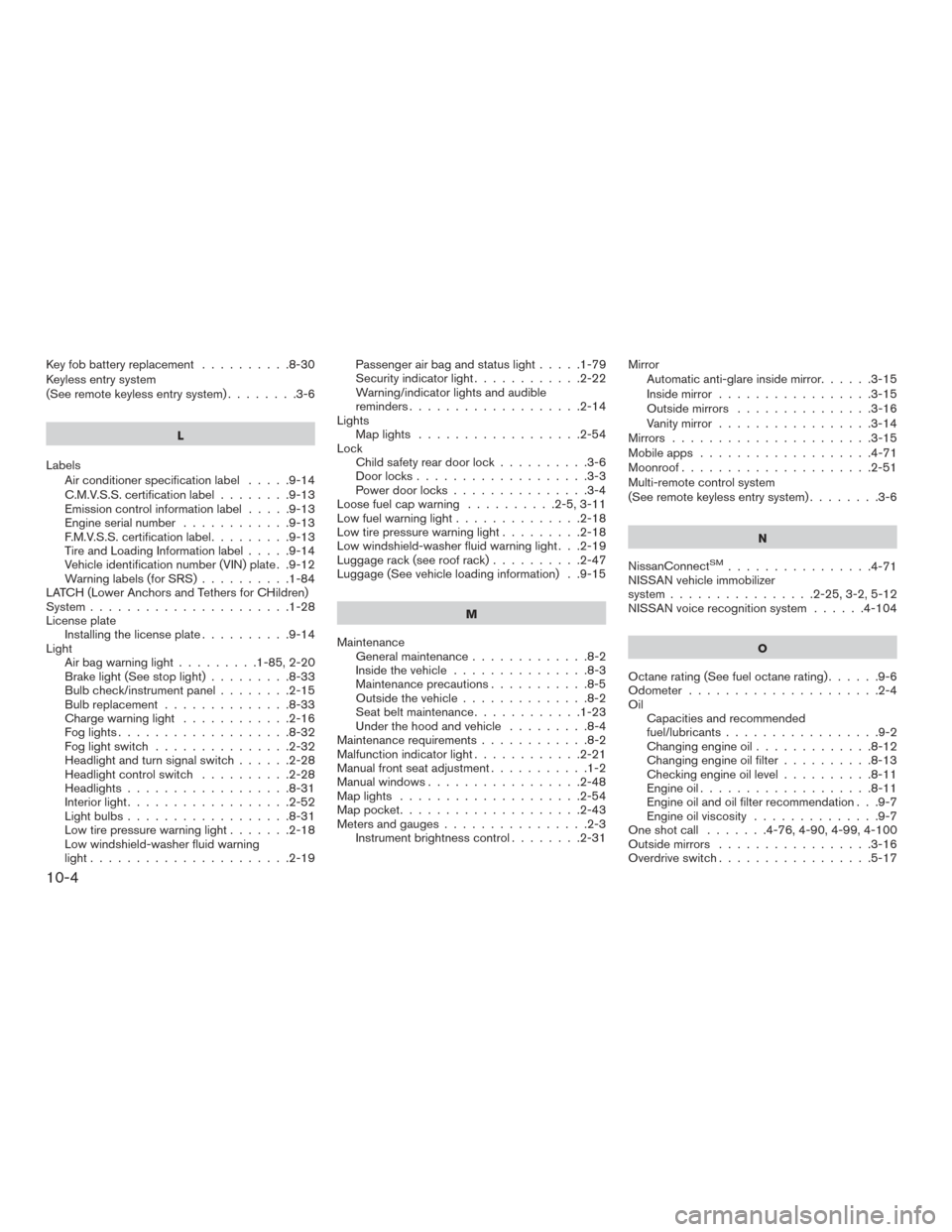
Key fob battery replacement..........8-30
Keyless entry system
(See remote keyless entry system) ........3-6
L
Labels Air conditioner specification label .....9-14
C.M.V.S.S. certification label ........9-13
Emissioncontrolinformationlabel.....9-13
Engine serial number ............9-13
F.M.V.S.S. certification label .........9-13
Tire and Loading Information label .....9-14
Vehicle identification number (VIN) plate . .9-12
Warning labels (for SRS) ..........1-84
LATCH (Lower Anchors and Tethers for CHildren)
System ......................1-28
License plate Installing the license plate ..........9-14
Light Airbagwarninglight.........1-85,2-20
Brake light (See stop light) .........8-33
Bulb check/instrument panel ........2-15
Bulb replacement ..............8-33
Charge warning light ............2-16
Foglights...................8-32
Foglightswitch ...............2-32
Headlight and turn signal switch ......2-28
Headlight control switch ..........2-28
Headlights ..................8-31
Interiorlight..................2-52
Lightbulbs..................8-31
Low tire pressure warning light .......2-18
Low windshield-washer fluid warning
light......................2-19 Passenger air bag and status light
.....1-79
Security indicator light ............2-22
Warning/indicator lights and audible
reminders ...................2-14
Lights Maplights ..................2-54
Lock Child safety rear door lock ..........3-6
Door locks ...................3-3
Power door locks ...............3-4
Loose fuel cap warning ..........2-5,3-11
Lowfuelwarninglight..............2-18
Low tire pressure warning light .........2-18
Low windshield-washer fluid warning light . . .2-19
Luggage rack (see roof rack) ..........2-47
Luggage (See vehicle loading information) . .9-15
M
Maintenance Generalmaintenance.............8-2
Insidethevehicle...............8-3
Maintenance precautions ...........8-5
Outside the vehicle ..............8-2
Seatbeltmaintenance............1-23
Underthehoodandvehicle .........8-4
Maintenancerequirements............8-2
Malfunction indicator light ............2-21
Manual front seat adjustment ...........1-2
Manual windows .................2-48
Maplights ....................2-54
Map pocket ....................2-43
Meters and gauges ................2-3
Instrument brightness control ........2-31Mirror
Automatic anti-glare inside mirror ......3-15
Inside mirror .................3-15
Outside mirrors ...............3-16
Vanity mirror .................3-14
Mirrors ......................3-15
Mobileapps ...................4-71
Moonroof .....................2-51
Multi-remote control system
(See remote keyless entry system) ........3-6
N
NissanConnect
SM................4-71
NISSAN vehicle immobilizer
system ................2-25,3-2,5-12
NISSAN voice recognition system ......4-104
O
Octane rating (See fuel octane rating) ......9-6
Odometer .....................2-4
Oil Capacities and recommended
fuel/lubricants.................9-2
Changingengineoil.............8-12
Changing engine oil filter ..........8-13
Checking engine oil level ..........8-11
Engineoil...................8-11
Engine oil and oil filter recommendation . . .9-7
Engine oil viscosity ..............9-7
Oneshotcall .......4-76,4-90,4-99,4-100
Outside mirrors .................3-16
Overdrive switch .................5-17
10-4
Page 462 of 466

OverheatIfyourvehicleoverheats...........6-13
Owner’s manual order form ...........9-42
Owner’s manual/service manual order
information ....................9-42
P
Parking Parking brake operation ...........5-20
Parking/parking on hills ...........5-33
Phone, Bluetooth® hands-free
system ...............4-73,4-87,4-97
Power Front seat adjustment .............1-4
Power door locks ...............3-4
Power outlet .................2-38
Power steering fluid .............8-15
Power steering system ...........5-34
Power windows ...............2-48
Rear power windows ............2-50
Power outlet ...................2-38
Power steering ..................5-34
Power steering fluid ...............8-15
Precautions Maintenance precautions ...........8-5
On-pavement and off-road driving
precautions ..................5-6
Precautions on booster
seats...........1-25,1-38,1-54,1-65
Precautions on child
restraints .........1-25,1-38,1-54,1-65
Precautionsonseatbeltusage.......1-15 Precautions on supplemental restraint
system
....................1-70
Precautions when starting and driving ....5-2
Pre-tensioner seat belt system .........1-83
Programmablefeatures..............4-7
Push starting ...................6-13
R
Radio Car phone or CB radio ...........4-72
FM-AM radio with compact disc (CD)
player .....................4-42
FM/AM/SAT radio with compact disc (CD)
player .................4-46,4-51
Steering wheel audio control switch ....4-69
Readiness for inspection maintenance (I/M)
test........................9-40
Rear power windows ..............2-50
Rearseat......................1-6
Rear sliding window ...............2-51
Rear sonar system ................5-40
Rear sonar system off switch ..........2-37
RearView Monitor .............4-10,4-13
Rear window defroster switch .........2-28
Recorders Eventdata..................9-41
Refrigerant recommendation ...........9-8
Registering your vehicle in another country . .9-12
Remote keyless entry system ...........3-6
Reporting safety defects (US only) .......9-39
Roof rack .....................2-47 S
Safety Child safety rear door lock ..........3-6
Child seat belts .....1-25,1-38,1-54,1-65
Reporting safety defects (US only) .....9-39
Seat Jumpseat ...................1-6
Seat adjustment Front manual seat adjustment ........1-2
Front power seat adjustment .........1-4
Seatbackpockets................2-44
Seat belt Child safety ..................1-24
Infants and small children ..........1-24
Injured
Person ................1-18
Largerchildren................1-25
Precautions on seat belt usage .......1-15
Pregnant women ...............1-18
Pre-tensioner seat belt system .......1-83
Seatbeltextenders .............1-23
Seatbeltmaintenance............1-23
Seatbelts...................1-15
Shoulder belt height adjustment ......1-22
Three-point type with retractor .......1-18
Seat belt extenders ...............1-23
Seatbeltwarninglight..........1-18,2-19
Seats Adjustment ...................1-2
Frontseats...................1-2
Heatedseats.................2-33
Manualfrontseatadjustment.........1-2
Rearseat....................1-6
Security indicator light ..............2-22
10-5
Page 463 of 466

Security system (NISSAN vehicle immobilizer
system) , engine start........2-25,3-2,5-12
Security systems Vehicle security system ...........2-24
Self-adjusting brakes ..............8-25
Service manual order form ...........9-42
Servicing air conditioner .............4-34
Setting button ...................4-7
Shifting Automatic transmission ...........5-14
Manual transmission .............5-18
Shift lock release .................5-16
Shoulder belt height adjustment ........1-22
Side air bag system (See supplemental side air
bag, curtain and rollover air bag systems) . . .1-82
Smartphone connectivity ............4-71
Sonar Rear system .................5-40
Spark plug replacement .............8-21
Spark plugs ...................8-21
Specifications ...................9-9
Speedometer ...................2-4
SRS warning label ................1-84
Stability control .................5-37
Starting Before starting the engine ..........5-12
Jump starting .............6-11,8-19
Precautions when starting and driving ....5-2
Push starting .................6-13
Starting the engine .............5-12
Starting the engine ...............5-12
Steering Power steering fluid .............8-15
Power steering system ...........5-34
Tilting steering wheel ............3-13
Steering wheel ..................3-13 Steering wheel audio control switch
......4-69
Stoplight.....................8-33
Storage......................2-39
Storage tray ................2-39,2-41
Sunglassescase.................2-43
Sunroof(seeMoonroof).............2-51
Sun visors ....................3-14
Supplemental air bag warning labels ......1-84
Supplemental air bag warning light . . .1-85, 2-20
Supplemental front impact air bag system . . .1-77
Supplemental restraint system Information and warning labels .......1-84
Precautions on supplemental restraint
system ....................1-70
Supplemental restraint system
(Supplemental air bag system) .........1-70
Switch Autolightswitch...............2-29
Automatic power window switch ......2-50
Clutch interlock (clutch start) switch ....2-37
Electronic locking rear differential (E-Lock)
system switch ................2-36
Foglightswitch ...............2-32
Hazard warning flasher switch ........6-2
Headlight and turn signal switch ......2-28
Headlight control switch ..........2-28
Hill descent control switch .........2-35
Ignition switch ................5-10
Instrument brightness control ........2-31
Overdrive switch ...............5-17
Power door lock switch ............3-4
Rear sonar system off switch ........2-37
Rear
window defroster switch .......2-28
Turn signal switch ..............2-32
Vehicle dynamic control (VDC) off switch. .2-34
Windshield wiper and washer switch . . .2-27 T
Tachometer ....................2-6
Tailgate ......................3-18
Tailgate latch ............3-18,3-22,3-23
Temperature gauge Engine coolant temperature gauge .....2-6
Theft (NISSAN vehicle immobilizer system) ,
engine start .............2-25,3-2,5-12
Three-way catalyst ................5-3
Tie down hooks .................3-23
Tilting steering wheel ..............3-13
Tire Flat tire .....................6-3
Spare tire ...................6-5
Tire and Loading Information label .....9-14
Tire chains ..................8-42
Tire pressure .................8-35
Tire rotation..................8-42
Tires of 4-wheel drive ............8-44
Types of tires .................8-41
Uniform tire quality grading .........9-38
Wheels and tires ...............8-35
Wheel/tire size ................9-10
Tire pressure Low tire pressure warning light .......2-18
Tire Pressure Monitoring System (TPMS) ....5-3
Top tether strap child restraint .........1-30
Towing 2-wheel drive models ............6-15
4-wheel drive models ............6-16
Flattowing..................9-37
Towing load/specification ..........9-30
Towtrucktowing...............6-14
Trailer towing .................9-26
10-6